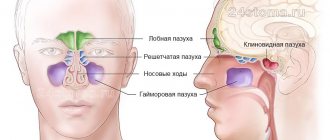Astigmatism - what is this pathology?
Translated from Latin, this word means “absence of a focal point.”
The name helps to understand what astigmatism is: it is a distortion of the image due to defocusing of optical rays passing through the eye apparatus. A healthy eye has a smooth, spherical surface of the cornea and lens. They are curved equally in all directions, allowing the eye to focus light and transmit a clear image to the retina.
What is astigmatism?
? In this condition, the sphericity of the cornea and, less commonly, the lens is impaired. Because of this, the refractive power on different parts of the surface is different, and optical rays are distorted. As a result, the image appears blurry or disproportionate.
Depending on what additional refractive errors are complicated by astigmatism, there are several types of it:
- Simple hyperopic: farsightedness in one main meridian and normal visual functions (emmetropia) in the second.
- Simple myopic: myopia in one main meridian and emmetropia in the other.
- Complex hyperopic: farsightedness is observed in both main meridians.
- Complex myopic: myopia in two main meridians.
- Mixed: a combination of farsightedness in one meridian and myopia in another.
Types of refractive errors
An astigmatic eye has two main mutually perpendicular meridians. One refracts the light beam more strongly, the second - weaker. The location of the eye meridians determines the variant of the existing astigmatism, namely:
- The direct type (stronger refraction in the vertical meridian) is recorded most often.
- Reverse ( increased refraction in the horizontal meridian) – is observed infrequently and causes a lot of discomfort to the patient.
- A defect with oblique axes is characterized by an inclined arrangement of the main meridians.
How does astigmatism affect vision?
We are all well aware of the concepts of myopia and farsightedness, when problems arise with the perception of objects at close or far distances. What is eye astigmatism and how does it affect vision? People suffering from this pathology see a distorted picture. Some areas (or all objects) may be blurry, while others may be out of proportion. Ophthalmologists like to draw an analogy with a reflection on a metal spoon: the picture is sometimes unclear, sometimes disproportionate. In this case, it absolutely does not matter at what distance the object is located.
The level of distortion of objects is influenced by the severity of the pathology. When the difference in meridians is less than 1 D (diopter), the distortions are almost invisible and do not cause discomfort to a person. In general, ophthalmologists distinguish three degrees of astigmatism:
- weak - up to 3 D;
- average - 3-6 D;
- high - more than 6 D.
A weak degree usually requires minimal correction. With moderate vision deterioration becomes noticeable, the outlines of objects “float”, treatment of astigmatism is necessary. A high degree is characterized by severe distortion of objects and a number of accompanying symptoms associated with increased visual fatigue: pain in the eyes, headaches, dizziness, double objects.
Here is a photo that shows what it is - eye astigmatism and how a person with such a pathology sees.
Complications
As a result of long-term uncompensated astigmatism, the following complications may occur:
Amblyopia. This disease is called lazy eye syndrome. Vision deteriorates as a result of restructuring of the nervous structures of the visual analyzer. The risk of pathology increases if two eyes have different degrees of astigmatism. Due to amblyopia, poor vision may persist even after surgical treatment. To avoid this complication, the disease should be treated as early as possible. Source: Satitpitakul V, Uramphorn N, Kasetsuwan N Factors predicting change in corneal astigmatism following suture removal in post-penetrating keratoplasty patients // Clin Ophthalmol. 2019 Aug 21;13:1593-1597. doi: 10.2147/OPTH.S213470. eCollection 2019
Strabismus. If a patient has poor vision for a long time and does not use glasses, he constantly squints, rolls his eyes, or resorts to other tricks in order to look at an object of interest to him, read a text, etc. Over time, this sometimes leads to squinting. It does not disappear even after surgical restoration of normal refraction and the patient acquiring high visual acuity.
If you have difficulty seeing, do not ignore the problem. Make an appointment with an ophthalmologist at SM-Clinic to have your vision checked.
Sources:
- K.V. Khripun, S.Yu. Astakhov. Correction of astigmatism with high degrees of hypermetropia - which method to choose? // Ophthalmological Gazette, 2014, vol.VII, no.2, pp.9-12.
- Remón L, Monsoriu JA, Furlan WD. Influence of different types of astigmatism on visual acuity // J Optom. 2017 Jul-Sep;10(3):141-148. doi: 10.1016/j.optom.2016.07.003. Epub 2016 Sep 14.
- Satitpitakul V, Uramphorn N, Kasetsuwan N. Factors predicting change in corneal astigmatism following suture removal in post-penetrating keratoplasty patients // Clin Ophthalmol. 2022 Aug 21;13:1593-1597. doi: 10.2147/OPTH.S213470. eCollection 2022.
Why does astigmatism occur?
Astigmatism can be congenital or acquired. Let's look at the reasons why this disease manifests itself.
| Congenital astigmatism | Acquired astigmatism |
| The cause is hereditary genetic changes that provoke disturbances in the sphericity of the lens or cornea of the eye: uneven development of the bones of the orbit, disruption of the eye muscles, etc. Congenital astigmatism can occur in albinos, children with congenital retinitis pigmentosa, as well as in fetal alcohol syndrome. | Acquired astigmatism manifests itself as a result of:
|
Symptoms of astigmatism
The first signs of astigmatism
appear in childhood. Unfortunately, kids can rarely formulate problems and explain that they are experiencing discomfort. That is why children are required to undergo examinations from the first months of life.
The main manifestation of eye astigmatism is blurred vision and blurred vision. In addition, the following symptoms may indicate pathology:
- increased eye fatigue;
- headache with visual stress;
- sensation of a foreign object in the eye;
- doubling of objects;
- burning, painful sensations in the eyes;
- difficulty maintaining attention;
- problems with visually determining the distance to objects.
Children's performance is falling.
They have difficulty reading and writing, confusing letters and numbers that are similar in spelling. It is especially important to identify astigmatism in time in children. If vision is not corrected promptly, amblyopia, or “lazy eye,” may develop. Due to the fact that during the early development of vision there is inadequate stimulation of the visual system (a constantly “blurred” picture), unequal refraction is formed, structural changes occur in the parts of the eyes and a significant decrease in vision that cannot be corrected is observed.
Various disease defects
Our eye refracts light fluctuatingly. This is explained by its anatomical structure, physiology and functions of refractive media. Normal physiological astigmatism is considered to be a deviation from the norm of up to 0.34 diopters. This condition does not impair vision, does not tire the eyes, does not cause headaches, double vision or asthenopic symptoms. Each of us can have this astigmatism.
A pathological defect, on the contrary, causes a lot of discomfort and is unfavorable for children. If it is not treated in time, the baby may develop strabismus or the so-called “lazy eye,” which cannot be corrected.
Diagnosis of astigmatism
In ophthalmology
Several methods are used to diagnose
astigmatism
. The most revealing is refractometry: an analysis of the refractive power of the eye, which allows us to identify refractive errors. Another popular method is visometry, a familiar vision test using tables. It is performed first without correction, and then with correction, when cylindrical lenses with different refractive powers are placed in front of the eye. Skiascopy, or the shadow test method, also helps identify problems: the patient is allowed to “try on” spherical and cylindrical lenses, and the doctor observes the movements of the shadows on the pupillary area.
The following may also be prescribed:
- Ultrasound of the eyeballs;
- computer keratotopography;
- ophthalmometry;
- autorefractometry and other methods.
Gymnastics for the eyes
Ophthalmic gymnastics works well at the initial stage of astigmatism development. Unfortunately, it cannot restore 100% visual acuity or correct refractive errors. Its role is to strengthen the eyes and gain the ability to better focus on objects. In addition, doctors call gymnastics the best way to prevent further development of the disease.
What exercises can you do for astigmatism?
- Focusing on objects of different distances
. An ordinary window is suitable as a simulator. You need to stand a meter away from him. First you need to focus your gaze on a point on the glass and fix it for 1 minute. Then look through this point at objects located at some distance outside the window. After 1 minute, the focus is shifted even further, and then they return to the starting point on the glass and repeat the exercise at least 3 times. - Oculomotor muscle training
. The patient closes his eyes tightly for 5-10 seconds, after which he opens them as much as possible, rotating the eyeballs first clockwise and then counterclockwise. Repeat the exercise at least 3 times for 1-2 minutes. - Training the extraocular muscles with closed eyelids
. Repeat the movements as in the previous exercise, but without opening your eyes tightly closed.
Instead of smooth rotations of the eyes, you can practice the maximum possible rotation of the eyeballs up and down, right and left, with a delay at the peak of tension for 5-10 seconds.
At the end of the series of exercises, you need to close your eyes, gently press your eyelids with your fingertips and massage them in a circular motion. It is important not to create excessive pressure: the massage should not be accompanied by discomfort.
How to treat astigmatism
Can astigmatism be cured? Yes, conservative and surgical methods are used for this. Let's look at each of them in more detail.
Optical correction of astigmatism
Glasses have been used for the longest time to correct astigmatism - this method has been used for more than 40 years. Glasses can have cylindrical or spherocylindrical lenses. Doctors determine the exact direction of the eye meridians, the degree of astigmatism, and associated refractions (myopia, farsightedness). Can astigmatism be treated with glasses? No, they only improve your vision while they are worn. Glasses have several disadvantages: they do a good job of correcting the image if a person is looking straight, but when the direction of gaze shifts, the image is distorted again. This can cause dizziness, nausea, and increased eye fatigue.
Using contact lenses is a more advanced method than wearing glasses. They fit tightly to the cornea, so they completely avoid distortion and correct vision not only in the center, but also in the periphery. Soft toric contact lenses are commonly used to correct astigmatism. Leading manufacturers: Alcon, Cooper Vision, iWear. You can view the catalog and study prices for such contact lenses in our catalog.
Surgical correction of astigmatism
For the treatment of astigmatism in adults
Today, laser vision correction is most often recommended. This procedure allows for a keratotomy - removing part of the cornea and reducing its refractive power - using high-precision lasers. The procedure is performed under local anesthesia and has virtually no complications.
If the cause of the pathology is deformation of the lens, surgery is performed to replace it. How is astigmatism treated in adults
in this manner? After a detailed examination, the ophthalmologist makes intraocular lenses (IOLs) that replace the damaged lens. Different types of IOLs can be used - toric, multifocal, phakic.
Another treatment method is thermokeratocoagulation: burning the cornea with a metal needle or laser beam. The thickness of the corneal tissue is reduced in the center of the optical zone or at the periphery. This allows you to increase the refractive power of the cornea.
For surgeries for astigmatism
there are
contraindications
. Thus, surgical intervention is impossible in case of retinal pathologies, problems with the cornea, some eye diseases (cataracts, glaucoma), in the presence of infectious diseases, diabetes mellitus, oncology, tuberculosis, during pregnancy and lactation.
Laser therapy
For irregular astigmatism, these procedures are prescribed for those who do not want to wear optics. Laser correction is carried out at the request of the patient and is the most popular method of surgical treatment of vision defects.
Contraindications for refractive surgery:
- Serious retinal damage;
- Decompensated diabetes mellitus;
- Eye inflammation, glaucoma or cataracts;
- Pregnancy and breastfeeding.
Laser therapy is very effective for patients with irregular astigmatism that cannot be corrected optically. The method will eliminate corneal defects and restore its standard configuration. After the operation, people begin to clearly see surrounding objects.
Prevention methods
Now that we have figured out how to cure astigmatism
, let's talk about how to prevent the development of pathology. It is necessary to visit an ophthalmologist regularly and have your vision tested to notice changes in the early stages. Gymnastics for the eyes will be useful: exercises will help relax the eye muscles, improve blood circulation and normalize metabolic processes.
To prevent astigmatism in children, it is worth making sure that the eyes are not overstrained: limit time with gadgets and monitor the correct position and light level during classes. Ophthalmologists also recommend regularly taking courses of multivitamins intended for the eyes.











